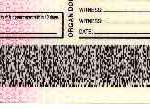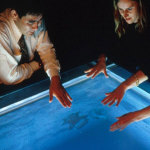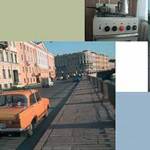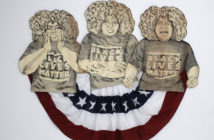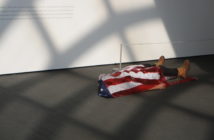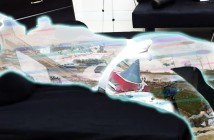New media artwork, activism and organization is happening in Boston despite lack of funding, lack of alternative and multi-use spaces and lack of city and state support. It's not just once every two years at the Boston CyberArts festival; it's not just at the MIT Media Lab. Growing numbers of new media artists, non-profit organizations and art collectives have sprung up in the city at the same time as ideas inspired by digital media and software have begun to influence the work of artists in the non-digital realm.
The best thing about "new media" is that the term is so tremendously vague and all-inclusive that there is no reigning definition of it. New media practice includes digital animation, interactive installation, interactive literature, internet art, software art, streaming performance, gaming, electronic music, virtual reality, artificial life, robotics, hacktivism, immersive environments, bionic performance systems and much, much more. Even Lev Manovich, the current reigning father-figure in the field, provided no less than eight propositions for the definition of new media in his introduction to The New Media Reader.
Since there is no standard definition of new media or accepted set of aesthetic guidelines, artists and practitioners are free to invent new media with each project, and artists in Boston are doing exactly that. Recent exhibits of new media work in the Boston area or by Boston artists have included everything from Fluxus performance at the Art Interactive in Cambridge to the Nature and Inquiry artist group's Invisible Hands, a public art project with wireless GPS systems, to Martin Wattenberg's IdeaLine, an internet art timeline commissioned by the Whitney Museum.
Turbulence.org, is one of the most recent additions to Boston's new media community. Turbulence is world-renowned as the first and foremost commissioning organization for Internet artworks. Helen Thorington, Executive Director, and Jo-Anne Green, Associate Director, both practicing artists, recently relocated to Boston from New York City.
Turbulence has been tremendously active in the past year. In addition to running its annual program to commission Internet artworks from New England and New York Internet artists, Turbulence was one of the leaders in forming ATBoston (Art Technology Boston), a year-old consortium of non-profit new media organizations in Boston. ATBoston's online New Media calendar is positioned to become a significant resource for new media artists and audiences in the region. Turbulence also co-organized, along with Brooke Knight and Emerson College, a lecture series called "Floating Points: Net Art Now" which is bringing Internet art superstars such as Christiane Paul and Steve Dietz to a Boston audience in Spring 2004.
I caught up with Turbulence in order to ask some questions about the move to Boston and the state of new media:
KANARINKA: What has it been like to come to Boston from New York? Are there many discernible differences in the new media worlds of these two cities?
JO-ANNE: New York has more of everything - alternative exhibition and performance spaces, residency programs, museums, galleries and, most importantly, money. At least since the 1950s, New York has been a magnet for artists intent on experimentation and the creation of new styles, genres, ideas and even movements...New York is where artists, composers and choreographers dissolved the boundaries between those disciplines: think of Cage, Cunningham, Rauschenberg, and Johns. New York is where engineering and art intersected in the 1960s, think Billy Kluver, Andy Warhol, Johns, Rauschenberg and E.A.T; where Happenings happened for the first time.
I've always found Boston more staid and traditional, with a handful of artists attempting to break the mold. There are no new media departments in Boston art schools...There are far fewer private foundations that support experimental work (I know of two that consistently support new media), and hardly any alternative performance/exhibition spaces. Mobius lost its space [Kanarinka: AND the Berwick Research Institute, AND the Oni Gallery, AND the Zeitgeist], and the Boston Film and Video Foundation just closed. Unless the City of Boston and the state are willing to create an infrastructure that supports artists and art making that do not fit neatly into the art market (supply and demand), I'm afraid I don't feel very optimistic about things changing.
New Radio and Performing Arts, Inc.'s [Turbulence's parent organization] mission has not changed at all. In fact, we're determined to educate the public about net art and have joined with Emerson College on a number of exciting new projects.
KANARINKA: How do you work with new media in your studio art practice?Do you work exclusively with new media? If not, what kinds of overlaps, gaps, blurs do you allow for in terms of genre and practice?
HELEN: This is an interesting question for me: As an artist I seem to be moving back and forth, between writing more or less "traditional texts" - for Jo's "9_11_Scapes," for instance (http://new-radio.org/jo/ scapes_1.html) -- and trying to push ahead with new media work in which I use both natural and programming language to suggest story. I've adapted the beginning of these texts for Jim Andrews' "Arteroids", which means it will have a "new media" manifestation. (http://turbulence.org/spotlight/arteroids/index.htm). But the texts were originally conceived as a narrative experiment of a wholly different kind. Unfortunately I'm not programmer enough to move it ahead. So I work on the experiments a bit, then jump back to creating more traditional work. Create sound/musical compositions. Think how I'd like them to be used in new media work. Write texts and think ditto.
Today's experiments in new media must integrate experiments with/in programming simultaneously, and programming is not my area of expertise. So my prediction for myself is that I'll go on jumping back and forth until I find a collaborator willing to take his/her chance with me, while at the same time watching all those younger graduates emerging from educational institutions and producing interesting new work with skills I wish I had.
KANARINKA: Is there a way in which digital technologies (the Internet, mobile devices, etc.) have made an article about a new media scene in a particular city (Boston) irrelevant? Or then again, is the notion of Boston (as place) expanded because of these technologies? Particularly for online work like the work Turbulence supports, is this work "in" Boston or is it in Boston and x and y and z and ... locations? How can we think about this?
JO-ANNE: The Internet has furthered the dissolution of geographic boundaries, yet organizations still have real street addresses and specific requirements related to "place" that they have to observe. New Radio and Performing Arts, Inc. is in New York, Boston and at http://new-radio.org. Our New York funders require that we support New York artists and serve a New York audience. Ditto for Massachusetts.
But while hundreds of thousands of Massachusetts residents go online everyday, how will they learn about "net art" if no one gives them specific directions? Once they learn about net art, a Google search will lead them to Turbulence and many many more sites devoted to net art. Which ones will they visit? Most art enthusiasts in the Boston area still rely on a print magazine - Art New England - to stay informed about goings on in Boston. It remains necessary to use offline distribution mechanisms to reach new audiences.
The World Wide Web makes art and artists paradoxically ubiquitous and invisible. Many artists are motivated to have their own web sites so that they may bypass the art institutions (to many, Turbulence fits within this category), and the "need" for their validation. However, the Internet has become so vast that it's easy for individuals to get completely lost/overlooked. Turbulence has responded with "artists' studios" to provide a more visible forum for those wishing to drive more traffic to their own sites. Regardless of the ubiquity of computers, portals like Turbulence and "place" specific articles like the one you're writing will are necessary for the foreseeable future. The more information we're confronted with, the better the filters will need to be.
The problem, of course, is once one begins filtering, i.e. selecting, one engages a model that the net was supposed to erase: those of hierarchies and centralized control. In other words, the network is supposedly decentralized: once portals like Turbulence, Rhizome, Furtherfield, Net Art Review, Low-Fi, Whitney ArtPort, etc. began going about their business, they began re-implementing the very structures the net was supposed to erase: a system of who's in and who's out.
HELEN: New Radio and Performing Arts, Inc. was incorporated in New York and can do business (read, raise funds) in New York State; it has a certificate of Foreign Corporation in Massachusetts and can do business there (read, raise funds). It is also on the Internet and there it does another kind of business worldwide: it exhibits and distributes to anyone anywhere who has access to the Internet the work of the New York and Massachusetts artists for whom it has raised funds. There are no geographical boundaries for that.
Except for fundraising then, we at New Radio and Performing Arts could be anywhere so long as there is access and we can afford the cost of connection. I personally chafe at the boundaries and limitations, and as we hope will become evident in coming years, we search for ways to make Turbulence not just a site that distributes to the world, but that reflects the world as well.
KANARINKA: Any closing comments?
JO-ANNE: This is a very exciting time to be an artist. Many young artists are fortunate enough to understand and create their own programming. Art schools are turning out artists with strong foundations in engineering, electronics, and telecommunications technologies. These skills open up a vast array of art making capabilities, and the opportunity to transcend the boundaries of art and science via technology. Technologies are also helping break down the boundaries between visual art, dance, music, performance, literature and poetry. Artists no longer need feel bound to one discipline and they can and do work with artists thousands of miles away to create new work. The boundary between artist and audience continues to be tested, and the idea of single author/artist genius too.
How will these young artists experimenting with bold new ideas and tools make their way in the world? Who will support work that exists everywhere and nowhere? Who will support work in multiple copies? Who will support work dependent on soon-to-be obsolete technologies? Who will support work difficult to archive and preserve? New Media requires new infrastructures, new patrons, new language, new critics. It is my belief that government subsidies are the only solution, but politicians behind the National Endowment for the Arts are quietly mandating preservation of what's known, safe, and old - Shakespeare! How will we reverse this trend? It's up to us.
- Decipher your 2-D barcode with help from the Swipe Collaboration, available at Turbulence.org.
- A-Volve, an interactive computer installation by Christa Sommerer & Laurent Mignonneau, currently on display at The Art Interactive in Cambridge.
- A screeen shot from Len Manovich’s Soft Cinema, which according to his website:mines the new creative possibilities at the intersection of cinema, software culture, and architecture.
Links:
Here's a small sampling of artists and organizations currently working with new media in Boston:
911 Gallery, Alex Metral, Andrew Neumann, The Art Interactive, ATBoston Consortium, The Berwick Research Institute, Boston CyberArts Festival, Brian Knep, Boston University's SCV Computer Graphics Lab, Carmin Karasic, Chris Csikszentmihályi, Collision Collective (MIT), Dana Moser, Dead Air Live, Deb Todd Wheeler, Denise Marika, Diane Willow, Do-While Studio, Dr. T, Eleanor Ramsey, iKatun, Jack Bachrach, kanarinka, Karl Sims, Lou Susi, Martin Wattenberg, Michael Mittelman (Aspect Magazine), Mike Hall, Mobius, Natalie Loveless, Nature and Inquiry artists group, Nita Sturiale, Rachel Perry Welty, Teresa Marrin Nakra, turbulence.org, Walter Wright
Kanarinka is a co-founder of iKatun, a Boston-based collaborative that creates multimedia, installation, and performance artworks in physical space and cyberspace.


